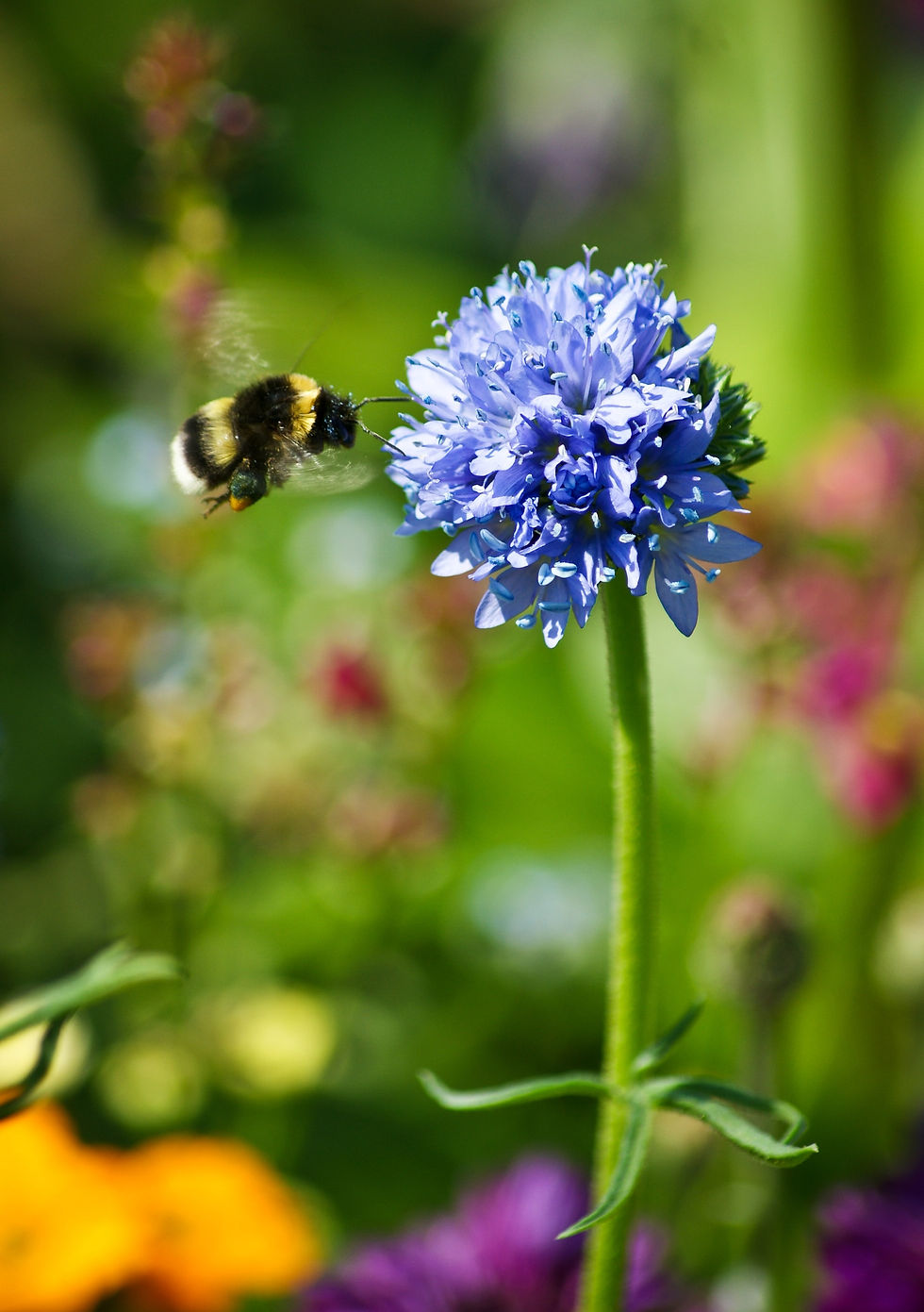Supporting Native Pollinators at Home, School, and Work
- Crystal M.
- Apr 1
- 4 min read

Bring the Buzz Back
Step outside on a sunny day in Sullivan County, New York, and you might catch a glimpse of a bumblebee weaving through a patch of wildflowers or a monarch butterfly fluttering above a milkweed plant. These quiet, beautiful moments aren’t just nature’s background noise — they are vital signs of a healthy ecosystem, and increasingly, they need our help.
Why Supporting Native Pollinators Matter
Bees, butterflies, moths, beetles, flies, and even hummingbirds are essential for fertilizing flowering plants, enabling fruits, vegetables, and seeds to grow. In fact, about 90% of all flowering plants and one in three bites of food we eat depend on animal pollinators (Laurentian ADK, 2022). That includes many of our local favorites — apples, cucumbers, squash, blueberries, and raspberries — all of which benefit from strong native pollinator populations.
Unfortunately, habitat loss, pesticide use, invasive species, and climate change have taken a toll. The Empire State Native Pollinator Survey found that several species once common in New York are now at risk, including the Rusty-patched Bumble Bee (Bombus affinis) and other solitary bees (ESNPS, 2022).
But here’s the good news: You don’t need a sprawling meadow to make a difference.

Creating Pollinator Havens — Wherever You Are
Whether you're a parent, gardener, backyard enthusiast, or early childhood educator, you can take meaningful steps to support pollinators right where you are.
At Home
Transform your garden or windowsill into a pollinator buffet. Choose native plants with staggered bloom times from early spring through late fall to ensure a continuous supply of nectar and pollen. In our region, great options include:
Black-eyed Susan (Rudbeckia hirta) – bright and bold, resistant to deer, and loved by bees (Laurentian ADK, 2022).
Bee balm (Monarda spp.) – fragrant and vibrant, attracts bees, butterflies, and hummingbirds.
Milkweed (Asclepias spp.) – essential for monarch butterflies to lay eggs and feed their caterpillars.
New England aster (Symphyotrichum novae-angliae) – supports late-season pollinators like bumblebees.
Wild bergamot and mountain mint – deer-resistant and highly attractive to many native bee species (Laurentian ADK, 2022).
Don’t be afraid to leave a few “messy” spots — bare soil for ground-nesting bees, leaf litter for overwintering butterflies, and even the occasional rotting fruit or log for beetles and other lesser-known helpers (Laurentian ADK, 2022).
At School

School gardens are powerful outdoor classrooms. By adding native flowering plants, children can witness the life cycles of butterflies, observe busy bees, and learn about ecology in real-time. Include interpretive signs, host pollinator observation days, or build a “bee hotel” with students to support solitary bees like mason and leafcutter bees (Laurentian ADK, 2022).
Even container gardens or a few raised beds can make a difference. Encourage students to spot species like the Common Eastern Bumble Bee (Bombus impatiens), Eastern Tiger Swallowtail, or the cheerful hoverfly. These small moments build lifelong environmental awareness.
At Work
From office parks to community centers, landscaping choices matter. Swap ornamental shrubs for native flowering perennials. Reduce mowing, limit pesticide use, and plant in clusters to maximize efficiency for visiting pollinators. Deer pressure can be intense in Sullivan County, so choose deer-resistant varieties like:
Goldenrod (Solidago spp.) – late bloomer and vital food source for migrating pollinators.
Penstemon (Penstemon digitalis) – tubular flowers ideal for long-tongued bees (Laurentian ADK, 2022).
Yarrow (Achillea millefolium) – feathery foliage, drought-tolerant, and unattractive to deer but beloved by bees (Laurentian ADK, 2022).
You’ll also enjoy fewer pest problems, more biodiversity, and a healthier landscape.
Pollinators + Fruit Trees = A Natural Partnership

The orchard at Valley Daycare is home to fruiting trees and berry bushes. These crops depend on pollinators to thrive. Without the work of native bees and butterflies, we’d see smaller harvests, fewer berries, and less ecological richness(ESNPS, 2022).
That’s why The Valley Fellowship is raising funds this year for the 2025 Valley Daycare Garden Project in honor of Children’s Gardening Month. With your help, we’ll expand pollinator-friendly planting around their orchard — creating space for children to learn, explore, and grow alongside buzzing, fluttering life.
Join Us!
🌼Support the 2025 Valley Daycare Garden Project🌼
Every donation helps us:
Plant more native, deer-resistant flowers that support local pollinators.
Offer hands-on nature education to children in our care.
Foster a healthier, more resilient garden for the whole community to enjoy.
🌱 Donate now to bring more beauty, biodiversity, and buzz to the garden — and give kids the gift of growing up connected to nature.
Sources & Further Reading:
Empire State Native Pollinator Survey (2022)
New York Natural Heritage Program
This comprehensive report documents the health and distribution of native pollinators across New York State. It highlights at-risk species, field survey methods, and ways communities can protect local pollinators through habitat support.
🔗 Available at: https://www.nynhp.org/pollinators/
Why Native Pollinators Matter (2022)
Laurentian Chapter of the Adirondack Mountain Club
A clear, practical guide for gardeners, educators, and land stewards. It explains the role of native pollinators and threats to their survival and offers a curated list of native, deer-resistant plants that support pollinator health throughout the seasons.
🔗 Read it here: https://pollinator.org/PDFs/Laurentian.rx9.pdf
Comments